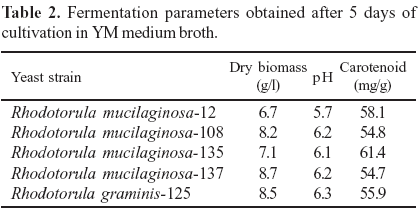The objective of the present study was to select and identify yeasts from Brazil capable of producing carotenoids. Pigmented yeasts were isolated from soil, leaves, fruits, flowers and a processed product. The samples were incubated at 30ºC in Erlenmeyer flasks, containing YM broth. After 48 hours, they were inoculated in Petri dishes with YM agar, and incubated at 30ºC during 120 hours. The yeast colonies, which presented yellow to red coloration, were transferred to culture tubes containing YM agar, and incubated at 30ºC for 72 hours. Out of 242 samples, only five had yellow to red color at high intensity. These highly pigmented yeasts were re-isolated in Petri dishes with YM agar and then transferred to tubes with GPYM agar. Identification through morphological and reproduction characteristics, along with physiological and biochemical tests, classified four strains as R. mucilaginosa and one strain as R. graminis. The main carotenoids extracted from them were identified through HPLC analysis as beta-carotene and torulene. The strains showed potential as promising microorganisms for the commercial production of carotenoids.
pigmented yeasts; identification; Rhodotorula; carotenoid; fermentation






